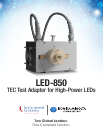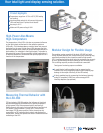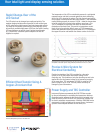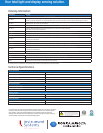
Your total light and display sensing solution.
Rapid Change-Over of the
LED Socket
The LED socket can be changed over easily and quickly. The
modular design principle makes it possible to test various types
of LED using just a single base unit and interchangeable sockets.
The range of LED sockets (with matching centering cap) covers
all commonly available high-power LEDs from the world‘s leading
LED manufacturers, as well as Level 2 printed circuit boards
(e.g. Luxeon Star). Customer-specific adapters can also be
supplied on request.
Precise 4-Wire System for
Electrical Contacting
Electrical contacting of the LED is provided by a four-wire
system, a set of test probes and contact springs in the
centering cap. This enables not only the operating current to be
applied but also the forward voltage to be measured precisely
at the same time. TEC test adapter LED-850 is rated for LED
power ratings of up to 10 W. The test probes can easily be
changed by users themselves.
Power Supply and TEC Controller
Instrument Systems recommends the 5305 TECSource made
by Arroyo Instruments for controlling the temperature. We have
developed control software for this device that is included in the
scope of delivery of the LED-850. This userfriendly software can
be used to automate measurements. A Keithley 2400/2600 series
sourcemeter is highly suitable as the current source. Instrument
Systems has developed software for this device, too.
Efficient Heat Transfer Using A
Copper-Zirconium Rod
Thermal simulation results: The LED is efficiently cooled and the heat at the Peltier
element dissipated by means of the heat sink
Setting time from ambient temperature (Tu=23°C and 35°C) to 15°C; LED power
dissipation 5 W; Peltier power rating 50W; PID parameters: P=80, I=0.3, D=0
The temperature of the LED is controlled by means of a gold-plated
copperzirconium rod that is pressed against the heat-conducting
slug of the LED’s housing by springs. The high thermal conductivity
of the copper-zirconium rod and the Peltier element – with maximum
cooling/heating capacity in excess of 120 W – allow the temperature
to be set quickly to the desired value within a range from +5 to
+85°C. In addition, a large heat sink and a fan assist efficient
dissipation of the heat loads. This results in temperature control
times of just a few minutes. What’s more, a PT100 temperature
sensor that guarantees setting accuracy down to 0.1°C is housed in
the copper-zirconium rod beneath the contact surface for the LED.








